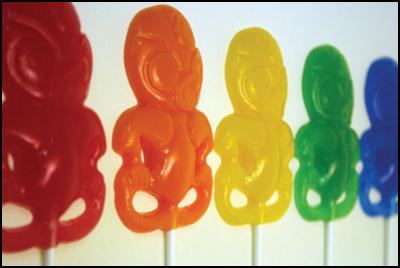Plastic Māori – A Tradition Of Innovation
PLASTIC MĀORI – A Tradition of Innovation

Wayne Youle, Often Liked, Occasionally Beaten, 2004. Resin hei tiki lollipops.
FOR IMMEDIATE RELEASE
PLASTIC MĀORI – A Tradition of
Innovation
14 March – 9 August 2009 / FREE
ENTRY
TheNewDowse / 45 Laings Road Lower Hutt / TheNewDowse / 45 Laings Road Lower Hutt /
www.newdowse.org.nz
When plastic tiki replace pounamu pendants and tekoteko panels are made out of computer keyboards, can these objects retain their cultural integrity? Is synthetic still authentic?
Plastic Māori is an exploration of artworks made by Māori artists who utilise plastic and other synthetic materials, curated by Blumhardt Foundation/Creative New Zealand Curatorial Intern Reuben Friend.
Friend says “I called the show ‘Plastic Māori’ because this slang term refers to a Māori person who is culturally uninformed, but pretends to know their stuff. The show looks at the issue of cultural authenticity in contemporary Māori art, and plays with these ideas of artificial identity and fabrication. A common belief shared by the artists I’ve selected is that a tradition of innovation exists in Māori culture. The artists reinterpret customary artforms in a way that enables them to comment on contemporary issues.”
Plastic Maori examines the appropriation, commodification and mass production of Māori taonga (treasures), with art works including kowhaiwhai lightboxes, tukutuku puzzle cubes, jewellery, streetwear and even NZ’s most famous plastic Māori – Manu from Playschool.
On 18-19 April, visitors can jump like the Easter bunny into Inez Crawford’s Bouncy Marae in TheNewDowse courtyard. Crawford uses the playful nature of this work to comment on the commercialisation of Maori art.
Public programmes include floor talks with artists Dr Robert Jahnke and Hemi MacGregor, and flax workshops in association with WEA. See www.huttcitywea.co.nz for booking details.
For more information and images, or to request an interview with Reuben Friend or participating artist/s, please contact:
ENDS
NOTES FOR EDITORS
The
artists featured in Plastic Māori are: Andre Te Hira, Aroha
Armstrong, Christina Wirihana, Gina Matchitt, Hemi
MacGregor, Inez Crawford, Jacob Scott, Michael Parekowhai,
Ngatai Taepa, Rangi Kipa, Dr Robert Jahnke, Suzanne Tamaki,
Tawa Hunter and Wayne Youle.
Reuben Friend is of
Pakeha and Ngati Maniapoto descent (Tainui), and currently
resides in Featherston, Wairarapa. He has a Bachelor of
Māori Visual Arts and Design from Te Wananga o Aotearoa and
is completing a Masters in Māori Visual Arts at Massey
University.


 Universities New Zealand - Te Pokai Tara: Young Mathematics Talent Bound For Cambridge With Sir Douglas Myers Scholarship
Universities New Zealand - Te Pokai Tara: Young Mathematics Talent Bound For Cambridge With Sir Douglas Myers Scholarship Yachting New Zealand: NZ Windfoil Star Starts New Olympic Campaign With Bronze At Princess Sofia
Yachting New Zealand: NZ Windfoil Star Starts New Olympic Campaign With Bronze At Princess Sofia E tū: Bupa Roster Changes Put Residents And Caregivers At Risk
E tū: Bupa Roster Changes Put Residents And Caregivers At Risk Democratic Voice of Burma: The Resilience And Hope Of Myanmar’s People On Screen In Auckland Sat April 5
Democratic Voice of Burma: The Resilience And Hope Of Myanmar’s People On Screen In Auckland Sat April 5 NZSEG: Powering The Future - NZSE College And Royal New Zealand Navy Forge Educational Partnership
NZSEG: Powering The Future - NZSE College And Royal New Zealand Navy Forge Educational Partnership Courtney Duncan: Illness Prevents Duncan From Contesting First Round Of 2025 World Women’s Motocross Championship
Courtney Duncan: Illness Prevents Duncan From Contesting First Round Of 2025 World Women’s Motocross Championship